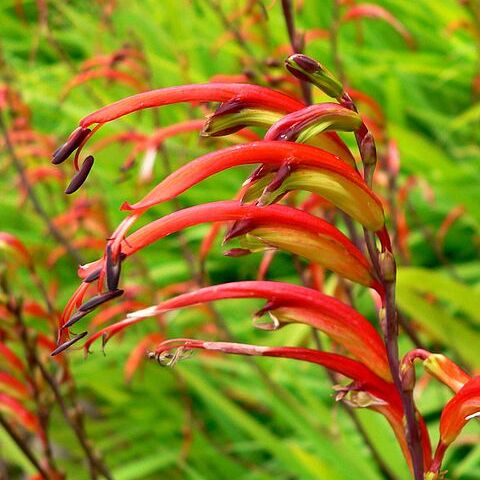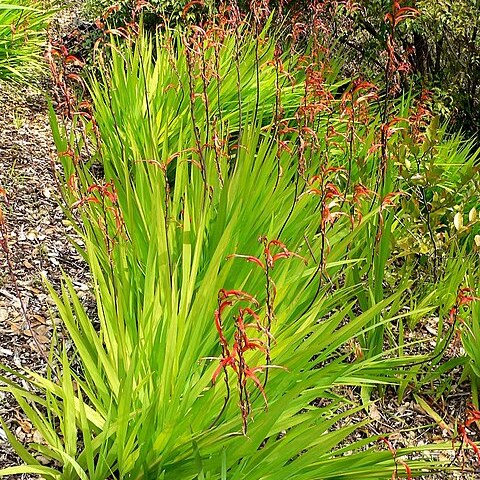Plants 60–120 cm; corm depressed-globose, 40–70 mm diam. Stems 1–2-branched. Leaves 8–10, mostly basal, basal longer than cauline; blade lanceolate, ± reaching base of spike, 18–35 mm wide. Spikes 25–40-flowered; outer spathe 13–15 mm, apex obtuse to truncate; inner ± equaling outer, apex bifurcate; flowers distichous. Tepals: perianth tube 35–45 mm, 9–12 mm proximally, often twisted, ca. 40 mm distally, base pouched; dorsal tepal horizontal, 28–33 × 7–9 mm, much exceeding others; lateral tepals patent or recurved, 12–15 × 4–7 mm; lower median tepal slightly smaller than laterals; filaments 50–55 mm; anthers 7–8 mm; ovary 6–9 mm, style branching shortly below and opposite to anthers (or exceeding them); branches 7–10 mm. Capsules 10–15 mm. Seeds 5–7 mm diam.
Perennial herb, 1-1.5 m tall. Corm to 6 cm diam.; tunic of netted fibres. Leaves 80-100 cm long, 2.2-4 cm wide; midvein prominent, asymmetric. Scape terete, glabrous, few-branched, often purplish, with 1-3 reduced leaves. Spikes distichous, 15-25 cm long, dense, 20-30-flowered. Bracts oblong, 1-1.5 cm long, membranous, red-brown. Flowers orange-red, rarely yellow, faintly striped. Perianth tube 3-4.5 cm long, narrow for c. 8 mm at base, distinctly pouched at junction with wider cylindrical upper portion; dorsal lobe oblanceolate to spathulate, hooded, 1.8-2.8 cm long; other lobes oblong, decurved, 1-1.7 cm long. Stamens arched under dorsal perianth lobe; anthers exserted, sagittate, c. 7 mm long, dark purplish. Style slightly exserted. Seeds smooth, orange.
Corm large, globose; tunic papery, netted. Stem ± 1.5 m high, sturdy, branched. Leaves < stem, to 5 cm wide, mostly cauline, ± stiff, erect, midvein noticeable. Spike 15-25 cm long, distichous, dense, 20-30-flowered; spathe-valves brownish purple-green, enclosing ½ narrow section of perianth-tube. Flowers ± 7.5 cm long, ± 3 cm diam., entirely reddish-orange or occasionally yellow-orange; tube ± 4.5 cm long, narrow lower part ± 8 mm long, twisted, curved upper part 3-4 cm long, somewhat truncate at base; upper lobe 3 cm long, spathulate, other lobes 1.5-2 cm long, 2 longer obtuse, 3 smaller ± acute. Anthers pinkish-red or yellow, projecting beyond longest perianth-lobe. Seeds sharply angled, black, shining.
Cormous geophyte, 0.6-1 m tall, with discoid corms with fibrous tunics, stems branched. Leaves sword-shaped. Flowers many in a 2-ranked erect spike, orange-red, perianth tube elongate, trumpet-shaped (rarely yellow).
Cormous geophyte, 45-100 cm, corm tunics firm-papery, becoming fibrous with age, stems branched. Flowers in a 2-ranked spike, tube flaring gradually, orange-red (rarely yellow).


